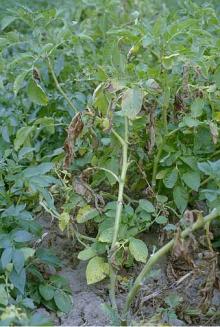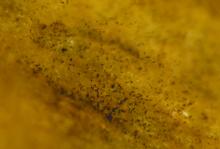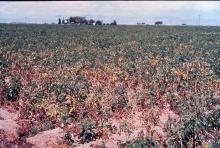By R. E. Ingham, P. B. Hamm, and C. M. Ocamb
Cause A fungus, Verticillium dahliae, which survives in soil or in infected plant parts. It infects through roots and invades the plant's water-conducting tissues, ultimately causing a wilt issue. Disease severity is proportionate to the inoculum density of the fungus in the soil. The varieties, BelRus, Shepody, Russet Norkotah, and Superior, are a few of many susceptible varieties. The variety Russet Burbank is considered moderately resistant. The variety Ranger Russet is more resistant but yield loss still occurs even in this variety when grown full season. An interaction with this disease and lesion nematodes (Pratylenchus penetrans) can cause further damage. A number of other disease organisms are involved with potato early dying, including black dot and bacterial soft rot, but Verticillium is the most important component.
Symptoms Vines prematurely yellow and die. Early symptoms are characterized by unilateral leaf yellowing. Later, wilted and/or dead plants stand upright. In cross-section, particularly at or below the soil line, damage plants exhibit a darkened vascular system. This disease can greatly reduce yield from the onset of disease symptoms.
Sampling Send soil samples to any of various public and private labs throughout the Pacific Northwest to determine the number of Verticillium propagules per unit of soil. For 'Russet Burbank', the threshold number is 10 CFU/gram of soil dry weight. The presence of lesion nematodes would reduce the threshold number needed to result in significant yield loss.
Cultural control
- Rotate with weed- and volunteer-free alfalfa or cereals.
- Optimum rates of nitrogen fertilizer reduce symptoms' severity.
- Irrigation management early in the growing season (prior to tuber initiation) can help reduce disease severity. Keep soil water availability from 75% to 100%.
- Use resistant varieties such as Century Russet, Ranger Russet, or Targhee.
- Green manure treatments of sudangrass or corn may help suppress disease.
Chemical control
- Soil fumigation gives economic control or suppression. Some labels call the disease "early maturity disease." Carefully read labels concerning new rules related to the use of buffer zones. For control of Verticillium wilt and Columbia root-knot nematode (Meloidogyne chitwoodi), or Verticillium wilt and stubby-root nematode (Paratrichodurus spp.) as a vector of tobacco rattle virus (causal agent of corky ringspot disease), use metam sodium or metam potassium in combination with Telone II. See label for details.
- Telone C-17 at 24 to 27.5 gal/A is registered for white potatoes. 5-day reentry. Restricted-use pesticide.
- Metam sodium 42% (Sectagon, Vapam HL, etc.) at a minimum of 38 (up to 75) gal/A through sprinkler irrigation systems in sufficient water to penetrate to the desired treatment depth. Meter continuously into the irrigation system throughout the entire application period. Soil temperature should be in the range of 40°F to 90°F (lower is better to reduce volatilization of product). Soil moisture immediately prior to treatment must be 50% to 80% of field capacity down to the 24-inch level. Soil condition must facilitate even water penetration without runoff. Generally target treatment down to about 10 inches, the level of soil tillage, and do not work soil lower than the point of treatment following fumigation. Fall fumigation is likely the best fit for PNW uses. Metam sodium can also be injected into soil using shanks, blades, fertilizer wheels, plows, etc. Follow immediately with a roller/packer to smooth and compact the soil surface to help prevent escape of fumigant. See specimen label for specific uses, rates and application methods. For optimum control of Verticillium, injectors should be placed 4 to 6 inches below the soil surface and 5 to 6 inches apart. If nematodes are targeted, an additional injection at 12 inches (and perhaps an additional 18 inches) is necessary. Metam sodium may also be applied at the rate of 50 to 75 gal/A using a Noble Plow Blade set to 12 to 14 inches deep with spray nozzles spaced every 6 inches apart to give uniform coverage, plus a surface application using a disc to immediately incorporate the surface application. Reduced rates of metam sodium can be used when used in combination with Telone II. See label for details. 48-hr reentry. Restricted-use pesticide.
- Metam potassium (54%) can be used in a similar fashion to metam sodium at rates of 30 to 60 gal/A. Restricted-use pesticide.
- Elatus (Group 11 + 7) at 0.34 to 0.5 oz/1,000 row feet applied in a 7-inches or less band either in-furrow at planting for disease suppression. Preharvest interval is 14 days. 12-hr reentry.
- Regalia (Group P5) at 1 to 2 quarts/A as an in-furrow treatment. Does not benefit from the addition of an adjuvant. 4-hr reentry. O
Biological control Efficacy unknown in Oregon.
- Bexfond at 7 to 14 fl oz/A. 4-hr reentry. O
- Double Nickel LC at 1 to 2 quarts/A as a banded soil spray or drench on 4- to 6-week intervals or at 0.5 to 4.5 pints/A on 2- to 4-week intervals . Can be applied the day of harvest. 4-hr reentry. O
- Stargus at 6 to 8 fl oz per 1,000 ft row as an in-furrow treatment, 3 to 4 quarts/A as a soil drench on 10- to 14-day intervals, or 3 to 4 quarts/A as a chemigation drip treatment on 14- to 21-day intervals. Preharvest interval is 0 days. 4-hr reentry. O
Reference Powelson, M.L., and Rowe, R.C. 1994. Potato early dying: Causes and management tactics in the eastern and western United States. In: Zehnder, G.W. et al. 1994. Advances in Potato Pest Biology and Management. St. Paul, MN: APS Press.





